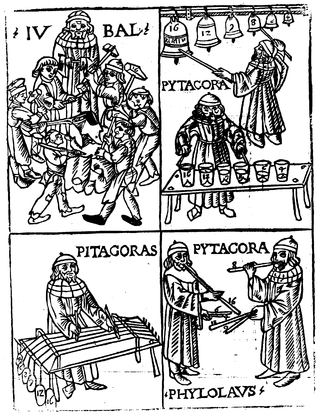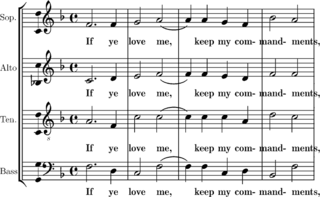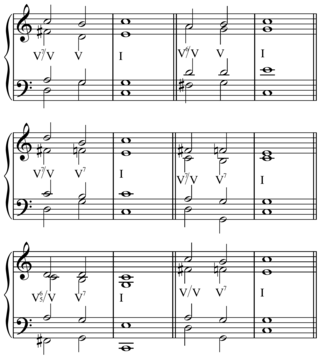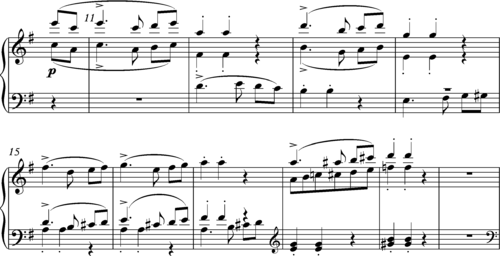
Polyphony is a type of musical texture consisting of two or more simultaneous lines of independent melody, as opposed to a musical texture with just one voice (monophony) or a texture with one dominant melodic voice accompanied by chords (homophony).

In music, harmony is the concept of combining different sounds together in order to create new, distinct musical ideas. Theories of harmony seek to describe or explain the effects created by distinct pitches or tones coinciding with one another; harmonic objects such as chords, textures and tonalities are identified, defined, and categorized in the development of these theories. Harmony is broadly understood to involve both a "vertical" dimension (frequency-space) and a "horizontal" dimension (time-space), and often overlaps with related musical concepts such as melody, timbre, and form.

Music theory is the study of the practices and possibilities of music. The Oxford Companion to Music describes three interrelated uses of the term "music theory": The first is the "rudiments", that are needed to understand music notation ; the second is learning scholars' views on music from antiquity to the present; the third is a sub-topic of musicology that "seeks to define processes and general principles in music". The musicological approach to theory differs from music analysis "in that it takes as its starting-point not the individual work or performance but the fundamental materials from which it is built."
In music theory, a leading-tone is a note or pitch which resolves or "leads" to a note one semitone higher or lower, being a lower and upper leading-tone, respectively. Typically, the leading tone refers to the seventh scale degree of a major scale, a major seventh above the tonic. In the movable do solfège system, the leading-tone is sung as ti.

In music, monophony is the simplest of musical textures, consisting of a melody, typically sung by a single singer or played by a single instrument player without accompanying harmony or chords. Many folk songs and traditional songs are monophonic. A melody is also considered to be monophonic if a group of singers sings the same melody together at the unison or with the same melody notes duplicated at the octave. If an entire melody is played by two or more instruments or sung by a choir with a fixed interval, such as a perfect fifth, it is also said to be monophony. The musical texture of a song or musical piece is determined by assessing whether varying components are used, such as an accompaniment part or polyphonic melody lines.

A chord, in music, is any harmonic set of pitches consisting of multiple notes that are sounded simultaneously, or nearly so. For many practical and theoretical purposes, arpeggios and other types of broken chords may also be considered as chords in the right musical context.
A nonchord tone (NCT), nonharmonic tone, or embellishing tone is a note in a piece of music or song that is not part of the implied or expressed chord set out by the harmonic framework. In contrast, a chord tone is a note that is a part of the functional chord (see Factor ). Non-chord tones are most often discussed in the context of the common practice period of classical music, but they can be used in the analysis of other types of tonal music as well, such as Western popular music.

In music, unison is two or more musical parts that sound either the same pitch or pitches separated by intervals of one or more octaves, usually at the same time. Rhythmic unison is another term for homorhythm.
Organum is, in general, a plainchant melody with at least one added voice to enhance the harmony, developed in the Middle Ages. Depending on the mode and form of the chant, a supporting bass line may be sung on the same text, the melody may be followed in parallel motion, or a combination of both of these techniques may be employed. As no real independent second voice exists, this is a form of heterophony. In its earliest stages, organum involved two musical voices: a Gregorian chant melody, and the same melody transposed by a consonant interval, usually a perfect fifth or fourth. In these cases the composition often began and ended on a unison, the added voice keeping to the initial tone until the first part has reached a fifth or fourth, from where both voices proceeded in parallel harmony, with the reverse process at the end. Organum was originally improvised; while one singer performed a notated melody, another singer—singing "by ear"—provided the unnotated second melody. Over time, composers began to write added parts that were not just simple transpositions, thus creating true polyphony.
In Western musical theory, a cadence is the end of a phrase in which the melody or harmony creates a sense of full or partial resolution, especially in music of the 16th century onwards. A harmonic cadence is a progression of two or more chords that concludes a phrase, section, or piece of music. A rhythmic cadence is a characteristic rhythmic pattern that indicates the end of a phrase. A cadence can be labeled "weak" or "strong" depending on the impression of finality it gives. While cadences are usually classified by specific chord or melodic progressions, the use of such progressions does not necessarily constitute a cadence—there must be a sense of closure, as at the end of a phrase. Harmonic rhythm plays an important part in determining where a cadence occurs. The word "cadence" sometimes slightly shifts its meaning depending on the context; for example, it can be used to refer to the last few notes of a particular phrase, or to just the final chord of that phrase, or to types of chord progressions that are suitable for phrase endings in general.

In music, homophony is a texture in which a primary part is supported by one or more additional strands that provide the harmony. One melody predominates while the other parts play either single notes or an elaborate accompaniment. This differentiation of roles contrasts with equal-voice polyphony and monophony. Historically, homophony and its differentiated roles for parts emerged in tandem with tonality, which gave distinct harmonic functions to the soprano, bass and inner voices.

In music, transcription is the practice of notating a piece or a sound which was previously unnotated and/or unpopular as a written music, for example, a jazz improvisation or a video game soundtrack. When a musician is tasked with creating sheet music from a recording and they write down the notes that make up the piece in music notation, it is said that they created a musical transcription of that recording. Transcription may also mean rewriting a piece of music, either solo or ensemble, for another instrument or other instruments than which it was originally intended. The Beethoven Symphonies transcribed for solo piano by Franz Liszt are an example. Transcription in this sense is sometimes called arrangement, although strictly speaking transcriptions are faithful adaptations, whereas arrangements change significant aspects of the original piece.

Barbershop arranging is the art of creating arrangements of barbershop music. The Barbershop Harmony Society (BHS) and Sweet Adelines International (SAI) have prescribed rules that dictate what is an acceptable arrangement, particularly with regard to singing in competition. This makes barbershop arranging a specialist form of arranging, rarely tackled by those outside barbershop; likewise, barbershop arrangers tend to be known only for their barbershop arrangements rather than for their work in any other musical form.

In music, imitation is the repetition of a melody in a polyphonic texture shortly after its first appearance in a different voice. The melody may vary through transposition, inversion, or otherwise, but retain its original character. The intervals and rhythms of an imitation may be exact or modified; imitation occurs at varying distances relative to the first occurrence, and phrases may begin with voices in imitation before they freely go their own ways.
Polyphony is a property of musical instruments that means that they can play multiple independent melody lines simultaneously. Instruments featuring polyphony are said to be polyphonic. Instruments that are not capable of polyphony are monophonic or paraphonic.

In music, homorhythm is a texture having a "similarity of rhythm in all parts" or "very similar rhythm" as would be used in simple hymn or chorale settings. Homorhythm is a condition of homophony. All voices sing the same rhythm. This texture results in a homophonic texture, which is a blocked chordal texture. Homorhythmic texture delivers lyrics with clarity and emphasis. Texture in which parts have different rhythms is heterorythmic or heterometric.

In music theory, voicing refers to two closely related concepts:
- How a musician or group distributes, or spaces, notes and chords on one or more instruments
- The simultaneous vertical placement of notes in relation to each other; this relates to the concepts of spacing and doubling
Traditional sub-Saharan African harmony is a music theory of harmony in sub-Saharan African music based on the principles of homophonic parallelism, homophonic polyphony, counter-melody and ostinato-variation. Polyphony is common in African music and heterophony is a common technique as well. Although these principles of traditional African music are of Pan-African validity, the degree to which they are used in one area over another varies. Specific techniques that used to generate harmony in Africa are the "span process", "pedal notes", "rhythmic harmony", "harmony by imitation", and "scalar clusters".
The Missa Brevis is a mass written by Giovanni Pierluigi da Palestrina first published in 1570 in Palestrina's Third Book of Masses and reprinted several times since. Its title may be misleading, as a missa brevis commonly refers to a short mass, which this is not. It is among the most performed of Palestrina's polyphonic repertoire.




















